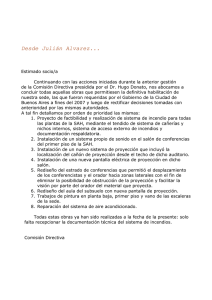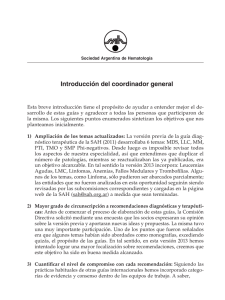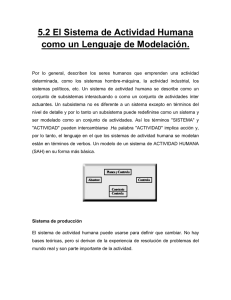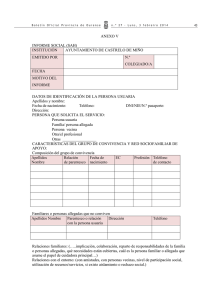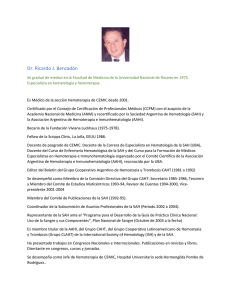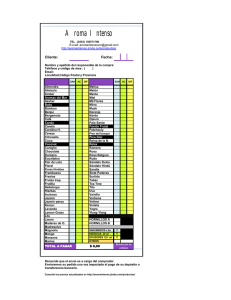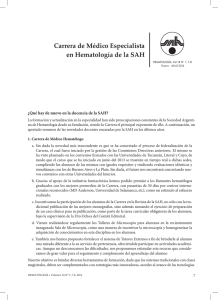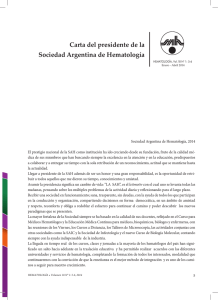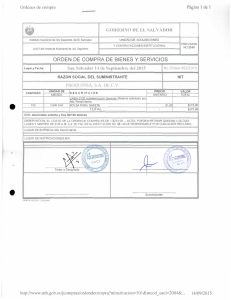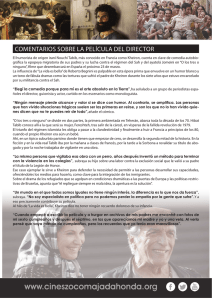Hemorragia subaracnoidea aneurismática manifestaciones clínicas y diagnóstico - UpToDate
Anuncio
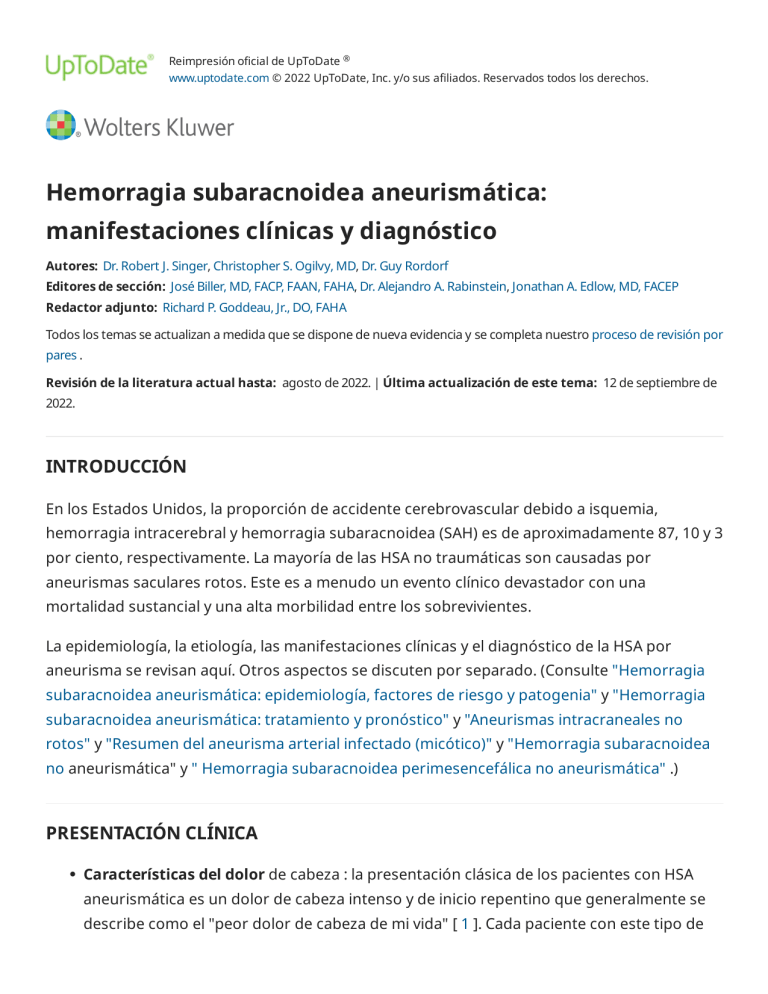
Reimpresión oficial de UpToDate ® www.uptodate.com © 2022 UpToDate, Inc. y/o sus afiliados. Reservados todos los derechos. Hemorragia subaracnoidea aneurismática: manifestaciones clínicas y diagnóstico Autores: Dr. Robert J. Singer, Christopher S. Ogilvy, MD, Dr. Guy Rordorf Editores de sección: José Biller, MD, FACP, FAAN, FAHA, Dr. Alejandro A. Rabinstein, Jonathan A. Edlow, MD, FACEP Redactor adjunto: Richard P. Goddeau, Jr., DO, FAHA Todos los temas se actualizan a medida que se dispone de nueva evidencia y se completa nuestro proceso de revisión por pares . Revisión de la literatura actual hasta: agosto de 2022. | Última actualización de este tema: 12 de septiembre de 2022. INTRODUCCIÓN En los Estados Unidos, la proporción de accidente cerebrovascular debido a isquemia, hemorragia intracerebral y hemorragia subaracnoidea (SAH) es de aproximadamente 87, 10 y 3 por ciento, respectivamente. La mayoría de las HSA no traumáticas son causadas por aneurismas saculares rotos. Este es a menudo un evento clínico devastador con una mortalidad sustancial y una alta morbilidad entre los sobrevivientes. La epidemiología, la etiología, las manifestaciones clínicas y el diagnóstico de la HSA por aneurisma se revisan aquí. Otros aspectos se discuten por separado. (Consulte "Hemorragia subaracnoidea aneurismática: epidemiología, factores de riesgo y patogenia" y "Hemorragia subaracnoidea aneurismática: tratamiento y pronóstico" y "Aneurismas intracraneales no rotos" y "Resumen del aneurisma arterial infectado (micótico)" y "Hemorragia subaracnoidea no aneurismática" y " Hemorragia subaracnoidea perimesencefálica no aneurismática" .) PRESENTACIÓN CLÍNICA ● Características del dolor de cabeza : la presentación clásica de los pacientes con HSA aneurismática es un dolor de cabeza intenso y de inicio repentino que generalmente se describe como el "peor dolor de cabeza de mi vida" [ 1 ]. Cada paciente con este tipo de dolor de cabeza, a menudo denominado "cefalea en trueno" (ver "Resumen de la cefalea en trueno" ), debe ser evaluado para HSA. La cefalea suele ser un hallazgo aislado. En pacientes neurológicamente intactos con un dolor de cabeza de inicio severo que alcanza su punto máximo dentro de una hora, tres grandes estudios secuenciales con un total de 5283 pacientes encontraron que 329 pacientes (6 por ciento) tenían SAH [ 2-5 ]. Es importante destacar que el inicio de la cefalea en la HSA no siempre se nota como instantáneo, ya sea porque el paciente no lo percibe de esa manera o porque el médico no obtiene esa información. En un estudio que incluyó a 132 pacientes con HSA, el tiempo hasta la intensidad máxima fue de una hora en seis (5 por ciento), y el acuerdo entre médicos para el inicio repentino fue solo moderado (kappa = 0,49) [ 2 ]. La ubicación no es útil ya que el dolor de cabeza puede ser localizado o generalizado. ● Síntomas asociados : además del dolor de cabeza, los síntomas asociados comunes de la SAH incluyen una pérdida breve del conocimiento, vómitos y dolor o rigidez en el cuello [ 6 ]. En una serie, estos ocurrieron en el 9, 61 y 75 por ciento de los pacientes, respectivamente, y cada uno de estos síntomas fue más común en pacientes con SAH en comparación con pacientes sin SAH [ 3 ]. El meningismo, a menudo acompañado de dolor lumbar, puede desarrollarse varias horas después de la hemorragia, ya que es causado por la descomposición de los productos sanguíneos en el líquido cefalorraquídeo (LCR), lo que conduce a una meningitis aséptica [ 7 ].]. Si bien muchos pacientes tienen un nivel alterado de conciencia, el coma es inusual. Las convulsiones ocurren durante las primeras 24 horas en menos del 10 por ciento de los pacientes, pero son un predictor de un mal resultado [ 8 ]. La HSA también puede presentarse como muerte súbita; hasta el 22 por ciento de los pacientes mueren antes de llegar al hospital [ 9 ]. ● Síntomas prodrómicos : algunos pacientes informan antecedentes de un dolor de cabeza intenso y repentino (el dolor de cabeza centinela) que precede a una hemorragia subaracnoidea mayor, que ocurre días o semanas antes de la ruptura del aneurisma. La cefalea centinela puede representar una hemorragia menor (una "fuga de advertencia") o cambios físicos dentro de la pared del aneurisma (p. ej., disección aguda, trombosis o expansión), pero los datos de respaldo son débiles. Una revisión sistemática de la literatura de estudios principalmente retrospectivos hasta septiembre de 2002 encontró que del 10 al 43 por ciento de los pacientes con HSA aneurismática informaron antecedentes de cefalea centinela o de advertencia [ 10 ]. Sin embargo, los datos retrospectivos pueden confundirse por el sesgo de recuerdo, y varios informes cuestionan la existencia de "fugas de advertencia" como la causa de las cefaleas centinela, según se revisa por separado. (Ver "Descripción general de la cefalea en trueno", sección sobre "Cefalea centinela" .) ● Entornos clínicos : mientras que el inicio de los síntomas en el entorno del esfuerzo físico, las actividades asociadas con una maniobra de Valsalva o el estrés emocional sugieren HSA, la HSA aneurismática ocurre con mayor frecuencia durante la actividad no extenuante, el descanso o el sueño [ 11,12 ]. (Consulte "Hemorragia subaracnoidea por aneurisma: epidemiología, factores de riesgo y patogénesis", sección sobre 'Patogénesis' ). ● Examination findings – Physical examination often shows hypertension and may show meningismus. Terson syndrome (preretinal hemorrhages) may be seen and implies a poorer prognosis. In a systematic review, patients with Terson syndrome had higher Hunt and Hess grades ( table 1) and significantly higher mortality than those without [13]. The preretinal hemorrhages of Terson syndrome may indicate a more abrupt increase in intracranial pressure and must be distinguished from the more benign retinal hemorrhages sometimes associated with SAH [14]. Casi cualquier signo neurológico puede estar presente ( tabla 2 ) y dependerá de la ubicación de la hemorragia, la presencia o ausencia de hidrocefalia, presión intracraneal elevada, isquemia, infarto o hematoma [ 15 ]. Aunque una parálisis del tercer nervio que afecta a la pupila a menudo se cita como un hallazgo de SAH, es más común con un aneurisma en expansión pero no roto de la arteria comunicante posterior o la arteria cerebelosa superior, que se encuentra cerca de donde el tercer nervio sale del tronco encefálico. 16,17 ]. Si está presente, este hallazgo exige un estudio de aneurisma que incluya alguna forma de angiografía cerebral, pero su ausencia no disminuye la probabilidad de SAH en pacientes con dolor de cabeza agudo. ● Clasificación de la gravedad : en la práctica, se utilizan varios sistemas de clasificación para estandarizar la clasificación clínica de los pacientes con HSA en el momento de la presentación inicial. Sin embargo, la evaluación del grado clínico en el momento del nadir, o después de la reanimación neurológica, parece ser más predictiva del resultado [ 18,19 ]. El sistema de clasificación propuesto por Hunt y Hess ( Mundial de Cirujanos Neurológicos (WFNS) ( tabla 1 ) y el de la Federación tabla 3 ) se encuentran entre los más utilizados. El sistema WFNS incorpora la escala de coma de Glasgow ( tabla 4 ) combinada con la presencia de déficit motor. La escala de Fisher es un índice de riesgo de vasoespasmo basado en un patrón de hemorragia definido por tomografía computarizada (TC) ( tabla 5 ), y la escala de Fisher modificada (también conocida como escala de Claassen) es un índice similar del riesgo de isquemia cerebral tardía. por vasoespasmo ( tabla 6 ). Un sistema propuesto por Ogilvy y Carter estratifica a los pacientes según la edad, el grado de Hunt y Hess, el grado de Fisher y el tamaño del aneurisma ( tabla 7 ). Además de predecir el resultado, esta escala substratifica con mayor precisión a los pacientes para la terapia. Las escalas de calificación para SAH se analizan con mayor detalle por separado. (Consulte "Escalas de clasificación de hemorragia subaracnoidea" .) EVALUACIÓN Y DIAGNÓSTICO When to suspect SAH — The complaint of the sudden or rapid onset of severe headache is sufficiently characteristic that SAH should always be considered in the evaluation. All patients with this complaint should undergo immediate evaluation for SAH beginning with head computed tomography (CT), even those who are alert and neurologically intact at the time of initial presentation [2,20]. Additional clues to the diagnosis of SAH, such as preretinal hemorrhages, neck pain, or meningismus, may or may not be present. In a systematic review and meta-analysis that included 22 diagnostic studies of emergency department patients evaluated for spontaneous SAH, the presence of meningismus on physical examination had a positive likelihood ratio of 6.6 [21]. ● Ottawa Subarachnoid Hemorrhage Rule – In neurologically intact patients presenting with acute nontraumatic headache that reached maximal intensity within one hour, a clinical decision rule (the Ottawa Subarachnoid Hemorrhage Rule) that included any of the following features had a sensitivity of 100 percent and a specificity of 15 percent for the diagnosis of SAH [2]: • Age ≥40 years • Neck pain or stiffness • Limited neck flexion on examination • Witnessed loss of consciousness • Onset during exertion • Thunderclap headache (instantly peaking pain) Subsequent validation studies, most from the same investigators, reported similar findings [3,22,23]. Moreover, application of this rule would have eliminated the need for evaluation in only 14 percent of patients [24]. ● Misdiagnosis and delayed diagnosis – Misdiagnosis and delayed diagnosis of SAH are common and can lead to delays in treatment and worse outcomes [25,26]. Missed or delayed diagnosis of SAH usually results from three errors ( table 8) [6,17]: • Failure to appreciate the spectrum of clinical presentation associated with SAH • Failure to obtain a head CT scan or to understand its limitations in diagnosing SAH • Failure to perform a lumbar puncture or correctly interpret the results Perhaps the most important source of misdiagnosis results from the misconception that patients with aneurysmal SAH always appear "sick" or have neurologic findings or altered mental status when in fact nearly 40 percent of patients are awake, alert, and neurologically intact [17]. Practitioners with the misconception may not perform CT scans in such patients. From a practice perspective, the vast majority of patients will be correctly diagnosed if all patients with thunderclap headache undergo head CT (and lumbar puncture if the CT is done after six hours from headache onset). Only an extremely small minority whose thunderclap headache is from a symptomatic but unruptured aneurysm would be missed by this approach [27-29]. The frequency of SAH misdiagnosis may be decreasing but remains a problem. In four studies of patients hospitalized with SAH published from 1980 to 1997, initial misdiagnosis rates ranged from 23 to 51 percent [1]. In contrast, a 2017 systematic review identified three studies published from 1996 to 2007 in emergency department populations with a pooled misdiagnosis rate of 7 percent [30]. Included the systematic review was a report of 482 patients admitted with SAH; initial misdiagnosis was independently associated with small SAH volume, normal mental status at presentation, and right-sided aneurysm location [25]. Failure to obtain a head CT scan at initial contact was the most common error, occurring in 73 percent of misdiagnosed patients. Among patients with SAH and normal mental status at first contact (45 percent), the misdiagnosis rate rose to 20 percent and was associated with a nearly fourfold increase in mortality at 12 months as well as increased morbidity among survivors. Standard diagnostic approach — The first step in the diagnosis of SAH is noncontrast head CT [20]. A lumbar puncture should be done if the head CT is negative [20]. If both tests are negative, they effectively eliminate the diagnosis of SAH as long as both tests are performed within two weeks of the event [27,31]. In cases presenting more than two weeks after headache onset (at such time when even xanthochromia may have disappeared), additional testing with noninvasive CT angiography (CTA) or magnetic resonance angiography (MRA) should be done. If diagnostic doubt remains, especially if the clinical context suggests other causes of acute-onset severe headache, magnetic resonance imaging (MRI), catheter cerebral angiography, or cerebral venography may be necessary ( table 9) [20]. (See "Overview of thunderclap headache".) The sensitivity of all diagnostic tests for SAH is time-dependent, measuring time from onset of the bleed. This is due to the physiologic brisk flow of cerebrospinal fluid (CSF). Normally, there is approximately 150 mL of CSF in a person's subarachnoid space at any point in time, but 450 to 500 mL are manufactured per 24 hours. This is why CT scans and red blood cell (RBC) counts are very sensitive early after bleeding onset but lose sensitivity with the passage of time. RBCs present in the CSF undergo lysis, resulting in breakdown products such as bilirubin and oxyhemoglobin, a process that takes time, accounting for the fact that xanthochromia is not sensitive early but becomes increasingly sensitive after a few hours. Head CT scan — The cornerstone of SAH diagnosis is the noncontrast head CT scan [32,33]. The head CT scan should be performed with thin cuts through the base of the brain to increase the sensitivity to small amounts of blood [34]. ● Sensitivity for SAH – The sensitivity of modern head CT for detecting SAH is highest in the first six hours after SAH (nearly 100 percent when interpreted by expert reviewers), and then progressively declines over time to approximately 58 percent at day 5 [28,33,3537]. In the largest study of the relation of time and CT sensitivity, the expert reviewers were attending-level general radiologists [38]. Clot is seen in the subarachnoid space in 92 percent of cases if the scan is performed within 24 hours of the bleed [33,38]. The sensitivity of head CT may be reduced with low-volume bleeds. In one study, for example, a minor SAH was not diagnosed by CT scan in 55 percent of patients; lumbar puncture was positive in all cases [39] However, the time from SAH onset to head CT was not reported. Anemia with hematocrits of 30 percent or less and poor scan quality due to patient movement are other causes of ambiguous or false-negative CT results. However, the most important factor that affects CT sensitivity is time from onset. ● Location of blood – Blood in SAH is generally found in the basal cisterns. Additional locations may include the sylvian fissures, interhemispheric fissure, interpeduncular fossa, and suprasellar, ambient, and quadrigeminal cisterns [15]. Intracerebral extension is present in 20 to 40 percent of patients and intraventricular and subdural blood may be seen in 15 to 35 and 2 to 5 percent, respectively. The distribution of blood on CT (performed within 72 hours after the bleed) is a poor predictor of the site of an aneurysm except in patients with ruptured anterior cerebral artery or anterior communicating artery aneurysms and in patients with a parenchymal hematoma [40]. However, the distribution of blood does have implications about whether or not the cause of the SAH is aneurysmal ( image 1). Blood restricted to the subarachnoid space in front of the brainstem suggests a nonaneurysmal perimesencephalic (also called pretruncal) SAH. Convexal SAH suggests reversible cerebral vasoconstriction syndrome (RCVS) in younger patients or cerebral amyloid angiopathy in older patients, whereas blood adjacent to bone in the anterior or middle cranial fossae suggests traumatic SAH. (See "Perimesencephalic nonaneurysmal subarachnoid hemorrhage".) Lumbar puncture — Lumbar puncture is mandatory if there is a strong suspicion of SAH despite a normal head CT [32,41]. Although controversial, one possible exception involves select patients with isolated headache, a normal examination, and a negative CT scan performed within six hours from onset of headache and interpreted by an expert reviewer, as discussed below. (See 'Need for LP when early CT is negative' below.) La punción lumbar debe incluir la medición de la presión de apertura, análisis de LCR de rutina, incluidos los recuentos de glóbulos rojos y glóbulos blancos (WBC), y la inspección visual de xantocromía. Los hallazgos clásicos de la punción lumbar de la SAH son una presión de apertura elevada, un recuento elevado de glóbulos rojos que no disminuye del tubo 1 al 4 del LCR y xantocromía. Puede ocurrir un traumatismo accidental en un capilar o una vénula durante la realización de una punción lumbar, lo que aumenta el número de glóbulos rojos y glóbulos blancos en el LCR. El diferencial de recuentos de glóbulos rojos entre los tubos 1 y 4, y la centrifugación inmediata del LCR, pueden ayudar a diferenciar el sangrado en la HSA del debido a una punción lumbar traumática: ● Aclaramiento de la sangre : se supone que el aclaramiento de la sangre (una disminución del recuento de glóbulos rojos con tubos de recolección sucesivos) es una forma útil de distinguir una punción lumbar traumática de la HSA. Sin embargo, este es un signo poco confiable de una punción traumática, ya que también puede ocurrir una disminución en el número de glóbulos rojos en las trompas posteriores en la HSA [ 42 ]. Este método puede excluir de manera confiable la SAH solo si hay un recuento sustancial de glóbulos rojos en el primer tubo y el tubo de recolección tardía o final es normal. Un estudio encontró que el cambio porcentual en el recuento de glóbulos rojos entre el primer y el último tubo fue más útil que la diferencia absoluta como prueba para distinguir la punción traumática de la hemorragia subaracnoidea; el umbral de prueba óptimo basado en esta muestra fue una reducción del 63 por ciento en el recuento de glóbulos rojos [ 43]. Estos hallazgos requieren una confirmación independiente. Si el líquido cefalorraquídeo está visiblemente sanguinolento, un método práctico para aumentar la probabilidad de que el último tubo de líquido cefalorraquídeo contenga casi cero glóbulos rojos es desechar el líquido cefalorraquídeo entre el primer y el último tubo con el objetivo de lograr una limpieza visual [ 20 ]. Dado el flujo rápido de LCR (se producen aproximadamente de 20 a 25 ml cada hora), incluso desechar 10 ml llevará solo 30 minutos para que el cuerpo los reemplace [ 44 ]. ● RBC count – The greater the RBC count in the last tube, the more likely SAH is the cause. In one study examining CSF results in 1739 patients with acute nontraumatic headache, fewer than 2000 RBCs/microL in addition to no xanthochromia excluded aneurysmal SAH with a sensitivity of 100 percent [45]. In a retrospective report of over 4400 adults who had lumbar puncture in the emergency department, finding fewer than 100 RBCs/microL in the CSF greatly decreased the likelihood of a SAH [43]. These results require independent prospective confirmation. ● Xanthochromia – Xanthochromia (pink or yellow tint) represents hemoglobin degradation products. An otherwise unexplained xanthochromic supernatant in CSF is highly suggestive of SAH. • Xanthochromia determined by visual inspection – Xanthochromia may be visually detected by comparing a vial of CSF with a vial of plain water held side by side against a white background in bright light [46]. The presence of xanthochromia indicates that blood has been in the CSF for at least two hours. Therefore, if the CSF is analyzed quickly after a traumatic lumbar puncture or SAH, there will not be xanthochromia; the absence of xanthochromia cannot be used as evidence of a traumatic tap if a lumbar puncture is performed in a SAH of less than two hours duration. Over the course of the ensuing hours, more patients will have xanthochromia, and by 12 hours post SAH, 100 percent of patients will have xanthochromia, even when measured visually [47]. Xanthochromia lasts for two weeks or more [48,49]. One retrospective study identified 117 adults with no known history of aneurysm or previous SAH who presented to the emergency room with thunderclap headache [50]. All had a negative noncontrast head CT followed by lumbar puncture. Xanthochromic CSF was found by visual inspection in 18 patients (15 percent). Those patients then had four-vessel catheter angiography, which detected a ruptured cerebral aneurysm in 13 (72 percent). One patient with no xanthochromia had an elevated RBC count (≥20,000 RBC/microL) in four successive collection tubes and a ruptured aneurysm by angiography. In this series, xanthochromia for the detection of cerebral aneurysms had a sensitivity and specificity of 93 and 95 percent. Other conditions that can produce xanthochromia include increased CSF concentrations of protein (150 mg/dL), systemic hyperbilirubinemia (serum bilirubin >10 to 15 mg/dL), and traumatic lumbar puncture with more than 100,000 RBCs/microL. (See "Cerebrospinal fluid: Physiology and utility of an examination in disease states", section on 'Xanthochromia'.) • Xanthochromia determined by spectrophotometry — Spectrophotometry detects blood breakdown products as they progress from oxyhemoglobin to methemoglobin and finally to bilirubin [48,51,52]. Bilirubin concentration peaks about 48 hours after SAH onset, and may last as long as four weeks after extensive, large-volume SAH [53]. While CSF spectrophotometry is more sensitive than visual inspection for xanthochromia, it is not universally recommended. As a practical matter, spectrophotometry of CSF is rarely available in North American hospitals [54]. The sample of CSF to be tested by spectrophotometry should be the one that contains the least amount of bloodstain. It should be protected from light and sent immediately to the laboratory for analysis [48,53]. Spectrophotometry for detection of bilirubin is highly sensitive (>95 percent) when lumbar puncture is done at least 12 hours after SAH [49]. Although xanthochromia is generally identified by visual inspection, laboratory confirmation with CSF spectrophotometry is more sensitive and is recommended by some experts, if available [48,53,55-57]. In one study, 11 analysts compared xanthochromic CSF samples using visual and spectrophotometric analysis [56]. The spectrophotometric detection of bilirubin was significantly higher than visual detection in conditions where CSF samples were contaminated by presence of hemolyzed blood, or when CSF samples contained low levels of bilirubin. However, in a study comparing visual inspection with spectrophotometry, CSF that was considered colorless by visual inspection was not compatible with a diagnosis of SAH [58]. Despite a higher sensitivity than visual inspection for the detection of xanthochromia, CSF spectrophotometry has only a low to moderate specificity for the diagnosis of SAH [59]. Alternative approaches — One alternative approach to the diagnosis of aneurysmal SAH is to follow a negative head CT with CTA rather than lumbar puncture (LP). Another involves omitting the LP for select patients who have a negative head CT performed within six hours of headache onset. The utility of MRI in place of head CT for detecting SAH is supported by limited data. CT followed by CTA — As CTA has become more available, some physicians have advocated the use of CTA (rather than LP) after a negative head CT for the diagnosis of aneurysmal SAH [60,61]. Chief among the various potential downstream implications is finding an asymptomatic aneurysm, which occurs in approximately 3 percent of the population [62,63]. Two cost-effectiveness studies concluded that the standard approach with CT followed by LP approach is equivalent or better than a CT/CTA approach [64,65]. Therefore, we recommend the standard approach using CT, followed by LP if CT is negative, reserving CTA for patients with a positive noncontrast CT or CSF analysis. Need for LP when early CT is negative — Because the consequences of missing SAH are potentially dire, we recommend a LP when the CT scan is negative for blood, as do most guidelines [41,61]. In contrast, some experts have argued that the sensitivity of CT when performed within six hours of the onset of symptoms is sufficiently sensitive (95.5 to 100 percent) to make a follow-up LP unnecessary [22,38,66,67]. In a prospective study that reported 95.5 percent sensitivity, there were five missed SAH cases, which included two false positives (attributed to a traumatic LP), one CT scan misinterpreted initially as negative for blood, one case of nonaneurysmal SAH, and one case of SAH that was not detected on CT due to anemia [22]. A meta-analysis published in 2016 found that less than 1.5 in 1000 patients with SAH would be missed if no LP was done in patients who met the following conditions: a normal head CT using a modern scanner within six hours of headache onset (with a clear time of onset); CT interpretation by an experienced radiologist; a normal neurologic examination; and presentation with an isolated thunderclap headache [28]. There are important caveats ( table 10) that suggest that this approach must be applied carefully and cautiously [20]. One is that such studies are performed in centers where CT scans are generally interpreted by expert reviewers (eg, at least the level of an attending radiologist). A second is that the sensitivity of CT may be reduced when symptoms are atypical, such as isolated neck pain. A third is that detection of blood on CT is unreliable when there is significant anemia (ie, hemoglobin <10g/dL [<100 g/l] or hematocrit <30 percent [<0.30]) [22,68]. Other experts have questioned whether LP is ever needed after a negative head CT in the diagnosis of SAH, based upon both Bayesian analysis (the post-test likelihood after a negative CT is sufficiently low to rule out SAH) and empiric data [21,69,70]. However, in a prospective study of patients with acute severe headache, the diagnosis of SAH was missed by CT in 17 of 119 patients (14 percent) with SAH who had initial CT performed more than six hours after the onset of headache [38]. We therefore continue to recommend LP after a negative CT, while other experts advise omitting the LP for select patients who meet all the criteria outlined in the table ( table 10). Brain MRI — Limited data suggest that proton density and fluid-attenuated inversion recovery (FLAIR) sequences on brain MRI may be as sensitive as head CT for the acute detection of SAH [71]. In addition, FLAIR and T2* sequences on MRI have a high sensitivity in patients with a subacute presentation of SAH (ie, 4 to 14 days from the onset of hemorrhage) [72]. However, MRI is seldom obtained as the first study for suspected SAH because it is typically less readily available than CT [15]. As with a negative CT scan, LP should follow a negative MRI if a patient is suspected to have SAH [41,73]. DIFFERENTIAL DIAGNOSIS Aneurysmal SAH is always the primary consideration when a patient presents with an abrupt onset headache. However, a number of other conditions listed in the table can cause a similar presentation ( table 9). These are discussed in detail separately. (See "Overview of thunderclap headache".) IDENTIFYING THE SOURCE OF BLEEDING Choosing initial angiography — Once a diagnosis of SAH has been made, the etiology of the hemorrhage must be determined with angiographic studies. We prefer conventional digital subtraction angiography (DSA) because it has the best resolution for the detection of aneurysms and can facilitate endovascular treatment as part of the same procedure. However, many centers use noninvasive imaging with computed tomography angiography (CTA) or magnetic resonance angiography (MRA) as the initial study, reserving DSA for cases when noninvasive imaging does not identify the cause of the SAH. A major advantage of CTA over DSA is the speed and ease by which it can be obtained, often immediately after the diagnosis of SAH is made by head computed tomography (CT) when the patient is still in the scanner. CTA is increasingly used as an alternative to DSA in many patients with SAH, thereby avoiding the need for DSA in some cases during the pre-interventional phase of management [74,75]. CTA is particularly useful in the acute setting in a rapidly declining patient who needs emergent craniotomy for hematoma evacuation. Furthermore, CTA offers a more practical approach to acute diagnosis than MRA, given the constraints of acute patient management. However, DSA will often be needed after CTA, as primary treatment when feasible should involve endovascular approaches. (See "Treatment of cerebral aneurysms".) Digital subtraction angiography — Of the available tests, DSA is believed to have the highest resolution to detect intracranial aneurysms and define their anatomic features and remains the gold standard test for this indication [41,76]. Most ruptured aneurysms can be readily identified using standard cross-sectional imaging techniques coupled with DSA that includes injections of bilateral vertebral and internal carotid arteries, as well as the external carotid circulation and deep cervical branches, all of which may supply a cryptic dural arteriovenous fistula. Angiographic demonstration of key branch points, including the proximal posterior circulation, is essential to definitively rule out aneurysm. As an increasing number of aneurysms are treated endovascularly, another advantage of DSA is the ability to both diagnose and then definitively treat the aneurysm in the same sitting. (See "Treatment of cerebral aneurysms".) The morbidity of DSA in patients with SAH is relatively low. In a meta-analysis of three prospective studies, for example, the combined risk of permanent and transient neurologic complications was significantly lower in patients with SAH compared with those with a transient ischemic attack (TIA) or stroke (1.8 versus 3.7 percent) [77]. CT and MR angiography — CTA and MRA are noninvasive tests that are useful for screening and presurgical planning. Both CTA and MRA can identify aneurysms ≥3 mm with a high degree of sensitivity [78], but they do not achieve the resolution of conventional angiography (ie, DSA). The sensitivity of CTA for the detection of ruptured aneurysms, using DSA as the gold standard, is 83 to 98 percent [79-85]. Small aneurysms (especially ≤2 mm) may not be reliably identified. Although small aneurysms rupture less frequently than large aneurysms [86], they are more common, and rupture of small aneurysms (approximately 5 mm or less) accounts for nearly one-half of SAH cases [87-89]. Therefore, DSA should be performed if CTA does not reveal an aneurysm in a patient with SAH [41]. As technology improves, the sensitivity and specificity of noninvasive imaging is also likely to improve [90]. A 2011 meta-analysis of CTA diagnosis of intracranial aneurysms found that, compared with single-detector CTA, use of multidetector CTA was associated with an overall improved sensitivity and specificity for aneurysm detection (both >97 percent) as well as improved detection of smaller aneurysms ≤4 mm in diameter [91]. Another systematic review and meta-analysis restricted to patients with SAH had similar findings [92]. While a "spot sign" (ie, contrast extravasation) on CTA is associated with risk of hemorrhage expansion or rebleeding in patients with intracerebral hemorrhage, this is not the case for SAH [93,94]. It is likely that this sign, while appearing similar, actually reflects different processes when observed in SAH versus intracerebral hemorrhage. Patients with negative angiography Repeat angiography — No angiographic cause of SAH is evident in 14 to 22 percent of cases. It is critical to repeat the angiogram in 4 to 14 days if the initial angiogram is negative. The recommended follow-up test in this setting is usually DSA. Up to 24 percent of all SAH patients with initial negative angiography have an aneurysm found on repeat angiography [95-99]. This may increase to as much as 49 percent if patients with perimesencephalic SAH and patients with normal CT scans are excluded [96]. Reasons for an initial false-negative angiogram include technical or reading errors, small aneurysm size, and obscuration of the aneurysm because of vasospasm, hematoma, or thrombosis within the aneurysm [95,96,100,101]. A third angiogram (DSA) at a period of two to three months is advocated by some, but is probably not necessary if the initial two studies are felt to be well-performed and expertly reviewed (see "Nonaneurysmal subarachnoid hemorrhage"). However, patients with SAH and a second negative angiogram should have a brain and spine MRI to look for possible vascular malformation of the brain or spinal cord [15]. Nonaneurysmal SAH — An estimated 15 to 20 percent of SAH cases are nonaneurysmal. The causes of nonaneurysmal SAH are potentially diverse, and include perimesencephalic hemorrhage, vascular malformations, intracranial arterial dissection, and a variety of other etiologies. The mechanism of bleeding in these cases is often not identified. (See "Nonaneurysmal subarachnoid hemorrhage".) Some patients with an initially negative angiogram have blood in the cisterns around the midbrain on head CT, which reflects a perimesencephalic pattern of hemorrhage ( image 2). Perimesencephalic hemorrhage accounts for about 10 percent of all cases of SAH and a majority of patients with nonaneurysmal SAH. Most patients with perimesencephalic hemorrhage do not have an aneurysm or other defined etiology. The need for repeat angiography in patients with perimesencephalic hemorrhage is discussed in detail separately. (See "Perimesencephalic nonaneurysmal subarachnoid hemorrhage", section on 'Repeated testing after technically inadequate initial study' and "Nonaneurysmal subarachnoid hemorrhage".) COMPLICATIONS A variety of early complications can occur with SAH, including rebleeding, hydrocephalus, cerebral edema, vasospasm and delayed cerebral ischemia, seizures, hyponatremia, cardiopulmonary abnormalities, and neuroendocrine dysfunction. These are discussed in detail separately. (See "Aneurysmal subarachnoid hemorrhage: Treatment and prognosis", section on 'Early complications'.) SOCIETY GUIDELINE LINKS Links to society and government-sponsored guidelines from selected countries and regions around the world are provided separately. (See "Society guideline links: Stroke in adults".) INFORMATION FOR PATIENTS UpToDate offers two types of patient education materials, "The Basics" and "Beyond the Basics." The Basics patient education pieces are written in plain language, at the 5th to 6th grade reading level, and they answer the four or five key questions a patient might have about a given condition. These articles are best for patients who want a general overview and who prefer short, easy-to-read materials. Beyond the Basics patient education pieces are longer, more sophisticated, and more detailed. These articles are written at the 10th to 12th grade reading level and are best for patients who want in-depth information and are comfortable with some medical jargon. Here are the patient education articles that are relevant to this topic. We encourage you to print or e-mail these topics to your patients. (You can also locate patient education articles on a variety of subjects by searching on "patient info" and the keyword(s) of interest.) ● Basics topics (see "Patient education: Hemorrhagic stroke (The Basics)" and "Patient education: Brain aneurysm (The Basics)" and "Patient education: Subarachnoid hemorrhage (The Basics)") ● Beyond the Basics topics (see "Patient education: Stroke symptoms and diagnosis (Beyond the Basics)" and "Patient education: Hemorrhagic stroke treatment (Beyond the Basics)") SUMMARY AND RECOMMENDATIONS ● Clinical presentation – The overwhelming majority of patients with aneurysmal subarachnoid hemorrhage (SAH) present with a sudden-onset severe headache, which may be associated with brief loss of consciousness, seizures, nausea or vomiting, or meningismus. (See 'Clinical presentation' above.) ● Evaluation and diagnosis – Sudden onset of headache, regardless of severity or prior headache history, should raise the clinical suspicion for SAH and compel a diagnostic evaluation. (See 'Evaluation and diagnosis' above.) • Imaging – Noncontrast head computed tomography (CT) reveals the diagnosis in more than 90 percent of cases if performed within 24 hours of bleeding onset. (See 'Head CT scan' above.) • Lumbar puncture – Lumbar puncture is mandatory if there is a strong suspicion of SAH despite a normal head CT, with the disputed exception of select patients with isolated headache and normal examination presenting early and scanned within six hours of headache onset. (See 'Lumbar puncture' above.) The classic findings are an elevated opening pressure, an elevated red blood cell count that does not diminish from cerebrospinal fluid (CSF) tube 1 to tube 4, and xanthochromia. Immediate centrifugation of the CSF can help differentiate bleeding in SAH from that due to a traumatic spinal tap. ● Identifying the source of bleeding – Once a diagnosis of SAH has been made, the etiology of the hemorrhage must be determined with vascular imaging. Of the available tests, digital subtraction angiography (DSA) has the highest resolution to detect intracranial aneurysms and define their anatomic features and remains the gold standard test for this, but CT angiography is being increasingly used as a first-line vascular test. (See 'Identifying the source of bleeding' above.) Repeat angiography is necessary if the initial study is negative, unless the pattern of hemorrhage is perimesencephalic, in which a repeat angiography may be considered optional. Additional testing is required for SAH that is nonaneurysmal. (See 'Patients with negative angiography' above.) Use of UpToDate is subject to the Terms of Use. Topic 1130 Version 27.0 GRAPHICS Hunt and Hess grading system for patients with subarachnoid hemorrhage Grade Neurologic status 1 Asymptomatic or mild headache and slight nuchal rigidity 2 Severe headache, stiff neck, no neurologic deficit except cranial nerve palsy 3 Drowsy or confused, mild focal neurologic deficit 4 Stuporous, moderate or severe hemiparesis 5 Coma, decerebrate posturing Based upon initial neurologic examination. Adapted from: Hunt W, Hess R. Surgical risk as related to time of intervention in the repair of intracranial aneurysms. J Neurosurg 1968; 28:14. Graphic 69179 Version 5.0 Focal physical findings in patients with subarachnoid hemorrhage Findings Likely cause Third nerve palsy Usually posterior communicating aneurysm; also posterior cerebral artery and superior cerebellar artery aneurysms Sixth nerve palsy Elevated intracranial pressure (false localizing sign) Combination of hemiparesis and aphasia or visuospatial neglect Middle cerebral artery aneurysm, thick subarachnoid clots, or parenchymal hematomas Bilateral leg weakness and abulia Anterior communicating artery aneurysm Ophthalmoplegia Internal carotid artery aneurysm impinging upon the cavernous sinus Unilateral visual loss or bitemporal hemianopia Internal carotid artery aneurysm compressing optic nerve or optic chiasm Impaired level of consciousness and impaired upward gaze Pressure on the dorsal midbrain due to hydrocephalus Brainstem signs Brainstem compression by basilar artery aneurysm Neck stiffness Meningeal irritation by the presence of subarachnoid blood Retinal and subhyaloid hemorrhages Sudden increase of intracranial pressure Preretinal hemorrhages (Terson syndrome) Vitreous hemorrhage due to severe elevations of intracranial pressure From: Suarez JI. Diagnosis and Management of Subarachnoid Hemorrhage. Continuum (Minneap Minn) 2015; 21:1263. DOI: 10.1212/CON.0000000000000217. Copyright © 2015 American Academy of Neurology. Reproduced with permission from Wolters Kluwer Health. Unauthorized reproduction of this material is prohibited. Graphic 121321 Version 2.0 World Federation of Neurological Surgeons subarachnoid hemorrhage grading scale Grade GCS score Motor deficit 1 15 Absent 2 13 to 14 Absent 3 13 to 14 Present 4 7 to 12 Present or absent 5 3 to 6 Present or absent GCS: Glasgow Coma Scale. Data from: Report of World Federation of Neurological Surgeons Committee on a Universal Subarachnoid Hemorrhage Grading Scale. J Neurosurg 1988; 68:985. Graphic 65468 Version 3.0 Glasgow Coma Scale (GCS) Score Eye opening Spontaneous 4 Response to verbal command 3 Response to pain 2 No eye opening 1 Best verbal response Oriented 5 Confused 4 Inappropriate words 3 Incomprehensible sounds 2 No verbal response 1 Best motor response Obeys commands 6 Localizing response to pain 5 Withdrawal response to pain 4 Flexion to pain 3 Extension to pain 2 No motor response 1 Total The GCS is scored between 3 and 15, 3 being the worst and 15 the best. It is composed of three parameters: best eye response (E), best verbal response (V), and best motor response (M). The components of the GCS should be recorded individually; for example, E2V3M4 results in a GCS score of 9. A score of 13 or higher correlates with mild brain injury, a score of 9 to 12 correlates with moderate injury, and a score of 8 or less represents severe brain injury. Graphic 81854 Version 9.0 Fisher grade of cerebral vasospasm risk in subarachnoid hemorrhage[1] Group Appearance of blood on head CT scan 1 No blood detected 2 Diffuse deposition or thin layer with all vertical layers (in interhemispheric fissure, insular cistern, ambient cistern) less than 1 mm thick 3 Localized clot and/or vertical layers 1 mm or more in thickness 4 Intracerebral or intraventricular clot with diffuse or no subarachnoid blood CT: computed tomography. Reference: 1. Fisher CM, Kistler JP, Davis JM. Relation of cerebral vasospasm to subarachnoid hemorrhage visualized by CT scanning. Neurosurgery 1980; 6:1. Graphic 81122 Version 4.0 Modified Fisher (Claassen) subarachnoid hemorrhage CT rating scale Grade Head CT criteria 0 No SAH or IVH 1 Minimal SAH and no IVH 2 Minimal SAH with bilateral IVH 3 Thick SAH (completely filling one or more cistern or fissure) without bilateral IVH 4 Thick SAH (completely filling one or more cistern or fissure) with bilateral IVH CT: computed tomography; SAH: subarachnoid hemorrhage; IVH: intraventricular hemorrhage. From: Claassen J, Bernardini GL, Kreiter K, et al. Effect of cisternal and ventricular blood on risk of delayed cerebral ischemia after subarachnoid hemorrhage: the Fisher scale revisited. Stroke 2001; 32:2012. Graphic 57558 Version 5.0 Ogilvy and Carter grading system to predict outcome for surgical management of intracranial aneurysms Criteria Points Age 50 or less 0 Age greater than 50 1 Hunt and Hess grade 0 to 3 (no coma) 0 Hunt and Hess grade 4 and 5 (in coma) 1 Fisher scale score 0 to 2 0 Fisher scale score 3 and 4 1 Aneurysm size 10 mm or less 0 Aneurysm size greater than 10 mm 1 Giant posterior circulation aneurysm size 25 mm or more 1 The total score ranges from 0 to 5, corresponding to grades 0 to 5 Adapted from: Ogilvy CS, Carter BS. A proposed comprehensive grading system to predict outcome for surgical management of intracranial aneurysms. Neurosurgery 1998; 42:959. Graphic 70705 Version 4.0 Reasons for misdiagnosis of subarachnoid hemorrhage[1] Failure to recognize spectrum of presentation of subarachnoid hemorrhage Not obtaining complete history from patients with unusual (for the patient) headaches Is the onset abrupt? Is the quality different and severity greater than prior headaches? Failure to appreciate that the headache can improve spontaneously or with non-narcotic analgesics Focusing on the secondary head injury resulting from syncope and fall or motor vehicle collision Focusing on ECG abnormalities Focusing on elevated blood pressure Overreliance on the classic presentation Misdiagnosis of other disorders (eg, viral syndrome, viral meningitis, migraine, tension-type headache, sinus-related headache, psychiatric disorder) Failure to understand the limitations of head CT scanning Sensitivity decreases as onset of headache increases False-negative results with small-volume bleeds Scan interpreted by inexperienced physician Motion artifacts or lack of thin cuts of posterior fossa False-negative results due to hematocrit of less than 30% Failure to perform lumbar puncture or interpret the CSF findings correctly Failure to perform lumbar puncture in patients with negative or inconclusive CT scans Failure to distinguish a traumatic tap from true subarachnoid hemorrhage Failure to recognize that xanthochromia may be absent very early (less than 12 hours) and very late (more than 2 weeks) ECG: electrocardiogram; CT: computed tomography; CSF: cerebrospinal fluid. Reference: 1. Suarez JI. Diagnosis and Management of Subarachnoid Hemorrhage. Continuum (Minneap Minn) 2015; 21:1263. Original figure modified for this publication. From: Edlow JA, Malek AM, Ogilvy CS. Aneurysmal subarachnoid hemorrhage: update for emergency physicians. J Emerg Med 2008; 34:237. Table used with the permission of Elsevier Inc. All rights reserved. Graphic 121322 Version 1.0 Etiologies of thunderclap headache Most common causes of thunderclap headache: Subarachnoid hemorrhage Reversible cerebral vasoconstriction syndromes (RCVS) Conditions that less commonly cause thunderclap headache: Cerebral infection (eg, meningitis, acute complicated sinusitis) Cerebral venous thrombosis Cervical artery dissection Spontaneous intracranial hypotension Acute hypertensive crisis Posterior reversible leukoencephalopathy syndrome (PRES) Intracerebral hemorrhage Ischemic stroke Conditions that uncommonly or rarely cause thunderclap headache: Pituitary apoplexy Colloid cyst of the third ventricle Aortic arch dissection Aqueductal stenosis Brain tumor Giant cell arteritis Pheochromocytoma Pneumocephalus Retroclival hematoma Spinal epidural hematoma Varicella zoster virus vasculopathy Vogt-Koyanagi-Harada syndrome Disputed causes of thunderclap headache: Sentinel headache (unruptured intracranial aneurysm)* Primary thunderclap headache¶ * Sentinel headache due to an unruptured intracranial aneurysm is a possible cause of thunderclap headache, but supporting data are weak. ¶ There is controversy as to whether thunderclap headache can occur as a benign and potentially recurrent headache disorder in the absence of underlying organic intracranial pathology. Graphic 81710 Version 8.0 Various radiologic patterns of subarachnoid hemorrhage on noncontrast comp tomography (CT) of the head (A) Obvious large SAH: hyperdense blood in all the basal cisterns, with some dilatation of the temporal h of the lateral ventricles, suggesting early hydrocephalus. (B) More subtle, smaller SAH: small hyperdense collection of blood in the basal cistern adjacent to the le and suprasellar cistern (short solid arrow). (C) Perimesencephalic SAH: the long solid arrows indicate a perimesencephalic (sometimes called a pret SAH. These hemorrhages represent approximately 10% of nontraumatic SAHs. They are thought to be cau venous bleeding, will have a negative CTA result, and usually have an excellent outcome. However, the radiographic pattern is also observed with posterior circulation aneurysms, so all of these patients requi neurosurgical consultation and vascular imaging. (D) Convexal SAH: the arrowheads indicate a high convexal SAH. This pattern is observed in two groups o patients. In younger patients, it is usually due to RCVS, but in older ones, it often indicates amyloid angio In a patient presenting with a severe rapid-onset headache, RCVS would be the likely diagnosis. (E) Traumatic SAH: the history usually suggests a traumatic SAH (the most common cause). However, if th pattern (dashed arrows indicate small amounts of SAH abutting bone, often in the anterior frontal and te bones) is observed in a patient without a clear history of trauma, the likely cause is a traumatic SAH. SAH: subarachnoid hemorrhage; CTA: computed tomography angiography; RCVS: reversible cerebral vasoconstriction syndrome. Reproduced from: Edlow JA. Managing Patients With Nontraumatic, Severe, Rapid-Onset Headache. Ann Emerg Med 2018; 71:400. Illustration used with the permission of Elsevier Inc. All rights reserved. Graphic 121315 Version 1.0 Considerations for omitting the lumbar puncture in patients who have a negative CT within six hours of headache onset in the evaluation for subarachnoid hemorrhage Patient factors The time of onset of the headache is clearly defined. The CT is performed within six hours of headache onset. The presentation is an isolated severe rapid-onset headache (no primary neck pain, seizure, or syncope at onset, or other atypical presentations). There is no meningismus and the neurologic examination result is normal. Radiologic factors The CT scanner is a modern, third-generation or newer machine with thin cuts through the brain. The CT is technically adequate, without significant motion artifact. The hematocrit level is >30%. The physician interpreting the scan is an attending-level radiologist (or has equivalent experience in reading brain CT scans). Radiologists should specifically examine the brain CTs for subtle hydrocephalus, small amounts of blood in the dependent portions of the ventricles, and small amounts of isodense or hyperdense material in the basal cisterns. Communication factors The clinician should communicate the specific concern to the radiologist (eg, "severe acute headache; rule out SAH"). After a negative CT result, the clinician should communicate the posttest risk of SAH that persists (1 to 2 per 1000). CT: computed tomography; SAH: subarachnoid hemorrhage. Reproduced from: Edlow JA. Managing Patients With Nontraumatic, Severe, Rapid-Onset Headache. Ann Emerg Med 2018; 71:400. Table used with the permission of Elsevier Inc. All rights reserved. Graphic 121294 Version 1.0 Perimesencephalic subarachnoid hemorrhage CT scan demonstrates the typical findings of a nonaneurysmal perimesencephalic subarachnoid hemorrhage. Note the predominance of hemorrhage in the interpeduncular fossa (arrow). CT: computed tomography. Courtesy of Guy Rordorf, MD. Graphic 72476 Version 4.0
